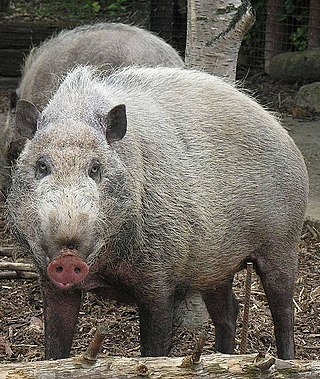
Sus is the genus of wild and domestic pigs, within the even-toed ungulate family Suidae. Sus include domestic pigs and their ancestor, the common Eurasian wild boar, along with other species. Sus species, like all suids, are native to the Eurasian and African continents, ranging from Europe to the Pacific islands. Suids other than the pig are the babirusa of Indonesia, the pygmy hog of South Asia, the warthogs of Africa, and other pig genera from Africa. The suids are a sister clade to peccaries.

Intensive pig farming, also known as pig factory farming, is the primary method of pig production, in which grower pigs are housed indoors in group-housing or straw-lined sheds, whilst pregnant sows are housed in gestation crates or pens and give birth in farrowing crates.
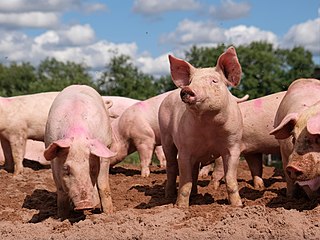
The pig, often called swine, hog, or domesticpig when distinguishing from other members of the genus Sus, is an omnivorous, domesticated, even-toed, hoofed mammal. It is variously considered a subspecies of Sus scrofa or a distinct species. The pig's head-plus-body length ranges from 0.9 to 1.8 m, and adult pigs typically weigh between 50 and 350 kg, with well-fed individuals even exceeding this range. The size and weight of hogs largely depends on their breed. Compared to other artiodactyls, a pig's head is relatively long and pointed. Most even-toed ungulates are herbivorous, but pigs are omnivores, like their wild relative. Pigs grunt and make snorting sounds.

The Gloucestershire Old Spots is an English breed of pig which is predominantly white with black spots. It is named after the county of Gloucestershire. The Gloucestershire Old Spots pig is known for its docility, intelligence, prolificity, and hardiness. Boars reach a mature weight of 600 lb (272 kg) and sows 500 lb (227 kg). The pigs are white with clearly defined black spots. There must be at least one spot on the body to be accepted in the registry. The breed's maternal skills enable it to raise large litters of piglets on pasture. Its disposition and self‑sufficiency should make it attractive for farmers raising pasture pigs and those who want to add pigs to diversified operations.
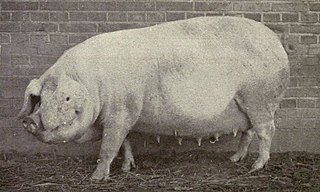
The Danish Landrace, Danish: Hvid Dansk Landrace, is a Danish breed of pig. It is of medium to large size, white in colour with a long body, fine hair, a long snout, and heavy drooping ears. There are two distinct varieties, the white and the piebald.

The Tamworth is a British breed of domestic pig. It is the only red-coloured British pig. Its origins are unknown, but it appears to have developed near the town of Tamworth in south-eastern Staffordshire, close to Warwickshire border. It is one of seven British pig breeds listed by the Rare Breeds Survival Trust as 'priority', the highest level of concern of the trust.

The Berkshire is a British breed of pig. It originated in the English county of Berkshire, for which it is named. It is normally black, with some white on the snout, on the lower legs, and on the tip of the tail.

Austin–Magie Farm and Mill District is a registered historic district near Oxford, Ohio, listed in the National Register on December 21, 1982. It contains 5 contributing buildings.
The Aksai Black Pied is a distinctively black and white spotted pig breed from Kazakhstan.
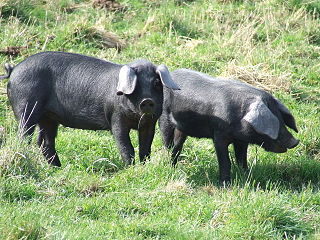
The Large Black pig is a British breed of domestic pig. It is the only British pig that is entirely black. It was created in the last years of the nineteenth century by merging the black pig populations of Devon and Cornwall in the south-west with those of Essex, Suffolk and Kent in the south-east. It is hardy, docile and prolific; it forages well and is suitable for extensive farming, but not well suited to intensive management.

Pig farming or pork farming or hog farming is the raising and breeding of domestic pigs as livestock, and is a branch of animal husbandry. Pigs are farmed principally for food and skins.

The Mangalica is a Hungarian breed of domestic pig. It was developed in the mid-19th century by crossbreeding breeds from the nearby Romanian Salonta and Hungarian Bakony with the European wild boar and the Serbian Šumadija breed. The Mangalica pig grows a thick, curly coat of hair. The only other pig breed noted for having a long coat is the extinct Lincolnshire Curly Coat pig of England.
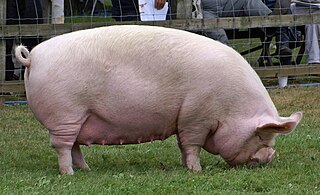
The Middle White is a British breed of domestic pig. It originated in Yorkshire, and derived from the Large White and the now-extinct Small White. It was recognised in 1852, and the first herd-book was published in 1884. It is a porker, reared for fresh pork, and is characterised by a short and sharply-upturned snout. After the Second World War it came close to extinction; although numbers have recovered somewhat, it is listed by the Rare Breeds Survival Trust as "priority" – the highest level of risk.

The Small White or Small Yorkshire was a British breed of domestic pig, common during the nineteenth century. It is now extinct, but its characteristics were used in producing the Middle White and other breeds.
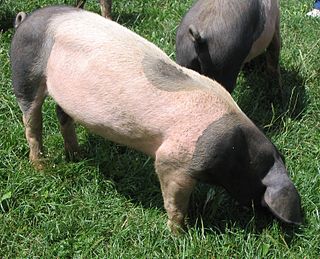
The Swabian-Hall swine is a breed of domestic pig originating from Schwäbisch Hall in Baden-Württemberg, Germany. It is a large pig, white in the centre with a black head and rear and narrow grey bands at the transition from white to black skin. They have large litters averaging more than nine piglets.

The British Landrace is a British domestic breed of pig and one of the most popular in the United Kingdom. It is pink with heavy drooping ears that cover most of the face and is bred for pork and bacon. The breed originated in the 1949 importation of 12 landrace pigs from Scandinavia — four boars and eight gilts. In 1950, the British Landrace Pig Society was formed and it opened a herd book for the first offspring born from the imported 12. They created the first pig testing scheme with a testing station at the village of Stockton-on-the-Forest in North Yorkshire.

The Hereford Hog or Hereford is an American breed of domestic pig. It is named for its color and pattern, which is similar to that of the Hereford breed of cattle: red with a white face.
The Lacombe is a breed of domestic pig native to Canada. Named for the Lacombe Research and Development Centre in Lacombe, Alberta, the breed was the first strain of livestock developed in the country.
The Duroc Italiana is the Italian strain of the American Duroc breed of domestic pig. It is the third most numerous pig breed in Italy, after the Large White Italiana and the Italian Landrace. It is one of the seven pig breeds of foreign origin recognised by the Ministero delle Politiche Agricole Alimentari e Forestali, the Italian ministry of agriculture and forestry, and one of the four for which a genealogical herdbook is kept by the Associazione Nazionale Allevatori Suini, the Italian national association of pig-breeders.
The Large White Ulster, or Ulster White, was a breed of domestic pig. Primarily bred for bacon production, it was the favoured breed of farmers in the north of Ireland up until the mid 20th century.

















